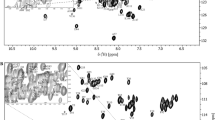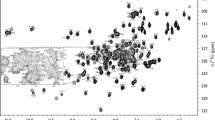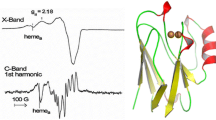Abstract
Calmodulin (CaM) binds to a linker between the oxygenase and reductase domains of nitric oxide synthase (NOS) to regulate the functional conformational dynamics. Specific residues on the interdomain interface guide the domain-domain docking to facilitate the electron transfer in NOS. Notably, the docking interface between CaM and the heme-containing oxygenase domain of NOS is isoform specific, which is only beginning to be investigated. Toward advancing understanding of the distinct CaM–NOS docking interactions by infrared spectroscopy, we introduced a cyano-group as frequency-resolved vibrational probe into CaM individually and when associated with full-length and a bi-domain oxygenase/FMN construct of the inducible NOS isoform (iNOS). Site-specific, selective labeling with p-cyano-l-phenylalanine (CNF) by amber suppression of CaM bound to the iNOS has been accomplished by protein coexpression due to the instability of recombinant iNOS protein alone. We introduced CNF at residue 108, which is at the putative CaM–heme (NOS) docking interface. CNF was also introduced at residue 29, which is distant from the docking interface. FT IR data show that the 108 site is sensitive to CaM–NOS complex formation, while insensitivity to its association with the iNOS protein or peptide was observed for the 29 site. Moreover, narrowing of the IR bands at residue 108 suggests the C≡N probe experiences a more limited distribution of environments, indicating side chain restriction apparent for the complex with iNOS. This initial work sets the stage for residue-specific characterizations of structural dynamics of the docked states of NOS proteins.
Graphical abstract




Similar content being viewed by others
Data availability
The data will be made available to others on reasonable request to the corresponding authors after publication.
Abbreviations
- NOS:
-
Nitric oxide synthase
- iNOS:
-
Inducible NOS
- nNOS:
-
Neuronal NOS
- eNOS:
-
Endothelial NOS
- CaM:
-
Calmodulin
- oxyFMN:
-
Bidomain oxygenase/FMN construct in which only the oxygenase and FMN domains are present, along with the CaM binding linker region
- CNF108 CaM:
-
CNF is introduced at 108 site on helix E within the C-lobe
- CNF29 CaM:
-
CNF is introduced at 29 site on helix B within the N-lobe
- p-iNOS:
-
Peptide containing the CaM binding region of iNOS
References
Moncada S, Higgs EA (2006) The discovery of nitric oxide and its role in vascular biology. Br J Pharmacol 147:193–201. https://doi.org/10.1038/sj.bjp.0706458. (FromNLMMedline)
Akanji MA, Adeyanju AA, Rotimi D, Adeyemi OS (2020) Nitric oxide balance in health and diseases: implications for new treatment strategies. Open Biochem J 14(1):25–32. https://doi.org/10.2174/1874091x02014010025
Lundberg JO, Weitzberg E (2022) Nitric oxide signaling in health and disease. Cell 185(16):2853–2878. https://doi.org/10.1016/j.cell.2022.06.010. (FromNLMMedline)
Mourad M, Aly O, Mourad A (2022) Nitric oxide: synthesis, pathophysiology and application on oncology and cardiovascular diseases. Octahedron Drug Res 1:34–49. https://doi.org/10.21608/odr.2022.154048.1001
Lancaster JR Jr, Xie K (2006) Tumors face NO problems? Cancer Res 66(13):6459–6462. https://doi.org/10.1158/0008-5472.CAN-05-2900. (FromNLMMedline)
Forstermann U, Sessa WC (2012) Nitric oxide synthases: regulation and function. Eur Heart J 33(7):829–837, 837a–837d. https://doi.org/10.1093/eurheartj/ehr304 (From NLM Medline)
Gantner BN, LaFond KM, Bonini MG (2020) Nitric oxide in cellular adaptation and disease. Redox Biol 34:101550–101561. https://doi.org/10.1016/j.redox.2020.101550. (FromNLMMedline)
Kurkin DV, Abrosimova EE, Bakulin DA, Kovalev NS, Dubrovina MA, Borisov AV, Strygin AV, Morkovin EI, Tyurenkov IN (2022) Activity modulation of various nitric oxide syntases as an approach to endothelial dysfunction therapy. Pharm Pharmacol 10(2):130–153. https://doi.org/10.19163/2307-9266-2022-10-2-130-153
Soundararajan L, Dharmarajan A, Samji P (2023) Regulation of pleiotropic physiological roles of nitric oxide signaling. Cell Signal 101:110496. https://doi.org/10.1016/j.cellsig.2022.110496
Roman LJ, Martásek P, Masters BSS (2002) Intrinsic and extrinsic modulation of nitric oxide synthase activity. Chem Rev 102:1179–1189. https://doi.org/10.1021/cr000661e
Li H, Poulos TL (2005) Structure-function studies on nitric oxide synthases. J Inorg Biochem 99(1):293–305. https://doi.org/10.1016/j.jinorgbio.2004. (FromNLMMedline)
Daff S (2010) NO synthase structures and mechanisms. Nitric Oxide 23:1–11. https://doi.org/10.1016/j.niox.2010.03.001
Leferink NG, Hay S, Rigby SE, Scrutton NS (2015) Towards the free energy landscape for catalysis in mammalian nitric oxide synthases. FEBS J 282(16):3016–3029. https://doi.org/10.1111/febs.13171. (FromNLMMedline)
Campbell MG, Smith BC, Potter CS, Carragher B, Marletta MA (2014) Molecular architecture of mammalian nitric oxide synthases. Proc Natl Acad Sci USA 111(35):E3614-3623. https://doi.org/10.1073/pnas.1413763111. (FromNLMMedline)
Volkmann N, Martasek P, Roman LJ, Xu XP, Page C, Swift M, Hanein D, Masters BS (2014) Holoenzyme structures of endothelial nitric oxide synthase—an allosteric role for calmodulin in pivoting the FMN domain for electron transfer. J Struct Biol 188(1):46–54. https://doi.org/10.1016/j.jsb.2014.08.006. (FromNLMMedline)
Yokom AL, Morishima Y, Lau M, Su M, Glukhova A, Osawa Y, Southworth DR (2014) Architecture of the nitric-oxide synthase holoenzyme reveals large conformational changes and a calmodulin-driven release of the FMN domain. J Biol Chem 289(24):16855–16865. https://doi.org/10.1074/jbc.M114.564005. (FromNLMMedline)
Arnett DC, Bailey SK, Johnso CK (2018) Exploring the conformations of nitric oxide synthase with fluorescence. Front Biosci Landmark 23:2133–2145. https://doi.org/10.2741/4694
Li J, Zheng H, Feng C (2018) Deciphering mechanism of conformationally controlled electron transfer in nitric oxide synthases. Front Biosci Landmark 23:1803–1821. https://doi.org/10.2741/4674
Astashkin AV, Li J, Zheng H, Feng C (2019) Positional distributions of the tethered modules in nitric oxide synthase: Monte Carlo calculations and pulsed EPR measurements. J Phys Chem A 123(32):7075–7086. https://doi.org/10.1021/acs.jpca.9b05388. (FromNLMMedline)
Bignon E, Rizza S, Filomeni G, Papaleo E (2019) Use of computational biochemistry for elucidating molecular mechanisms of nitric oxide synthase. Comput Struct Biotechnol J 17:415–429. https://doi.org/10.1016/j.csbj.2019.03.011. (FromNLMPubMed-not-MEDLINE)
Sessa WC, Harrison JK, Barber CM, Zeng D, Durieux ME, D’Angelo DD, Lynch KR, Peach MJ (1992) Molecular cloning and expression of a cDNA encoding endothelial cell nitric oxide synthase. J Biol Chem 267(22):15274–15276. https://doi.org/10.1016/s0021-9258(19)49528-8
Ruan J, Xie Q, Hutchinson N, Cho H, Wolfe GC, Nathan C (1996) Inducible nitric oxide synthase requires both the canonical calmodulin-binding domain and additional sequences in order to bind calmodulin and produce nitric oxide in the absence of free Ca2+. J Biol Chem 271(37):22679–22686. https://doi.org/10.1074/jbc.271.37.22679. (FromNLMMedline)
Tejero J, Hannibal L, Mustovich A, Stuehr DJ (2010) Surface charges and regulation of FMN to heme electron transfer in nitric-oxide synthase. J Biol Chem 285(35):27232–27240. https://doi.org/10.1074/jbc.M110.138842. (FromNLMMedline)
Li W, Chen L, Lu C, Elmore BO, Astashkin AV, Rousseau DL, Yeh SR, Feng C (2013) Regulatory role of Glu546 in flavin mononucleotide-heme electron transfer in human inducible nitric oxide synthase. Inorg Chem 52(9):4795–4801. https://doi.org/10.1021/ic3020892. (FromNLMMedline)
Haque MM, Tejero J, Bayachou M, Kenney CT, Stuehr DJ (2018) A cross-domain charge interaction governs the activity of NO synthase. J Biol Chem 293(12):4545–4554. https://doi.org/10.1074/jbc.RA117.000635. (FromNLMMedline)
Li J, Zheng H, Wang W, Miao Y, Sheng Y, Feng C (2018) Role of an isoform-specific residue at the calmodulin-heme (NO synthase) interface in the FMN—heme electron transfer. FEBS Lett 592(14):2425–2431. https://doi.org/10.1002/1873-3468.13158. (FromNLMMedline)
Haque MM, Bayachou M, Tejero J, Kenney CT, Pearl NM, Im SC, Waskell L, Stuehr DJ (2014) Distinct conformational behaviors of four mammalian dual-flavin reductases (cytochrome P450 reductase, methionine synthase reductase, neuronal nitric oxide synthase, endothelial nitric oxide synthase) determine their unique catalytic profiles. FEBS J 281(23):5325–5340. https://doi.org/10.1111/febs.13073. (FromNLMMedline)
Hedison TM, Hay S, Scrutton NS (2017) A perspective on conformational control of electron transfer in nitric oxide synthases. Nitric Oxide 63:61–67. https://doi.org/10.1016/j.niox.2016.09.002. (FromNLMMedline)
Hanson QM, Carley JR, Gilbreath TJ, Smith BC, Underbakke ES (2018) Calmodulin-induced conformational control and allostery underlying neuronal nitric oxide synthase activation. J Mol Biol 430(7):935–947. https://doi.org/10.1016/j.jmb.2018.02.003. (FromNLMMedline)
Tucker MJ, Oyola R, Gai F (2006) A novel fluorescent probe for protein binding and folding studies: p-cyano-phenylalanine. Biopolymers 83(6):571–576. https://doi.org/10.1002/bip.20587. (FromNLMMedline)
Creon A, Josts I, Niebling S, Huse N, Tidow H (2018) Conformation-specific detection of calmodulin binding using the unnatural amino acid p-azido-phenylalanine (AzF) as an IR-sensor. Struct Dyn 5(6):064701–064712. https://doi.org/10.1063/1.5053466FromNLMPubMed-not-MEDLINE
Zhang J, Wang L, Zhang J, Zhu J, Pan X, Cui Z, Wang J, Fang W, Li Y (2018) Identifying and modulating accidental fermi resonance: 2D IR and DFT study of 4-azido-l-phenylalanine. J Phys Chem B 122(34):8122–8133. https://doi.org/10.1021/acs.jpcb.8b03887. (FromNLMMedline)
Venema RC, Sayegh HS, Kent JD, Harrison DG (1996) Identification, characterization, and comparison of the calmodulin-binding domains of the endothelial and inducible nitric oxide synthases. J Biol Chem 271(11):6435–6440. https://doi.org/10.1074/jbc.271.11.6435
Ghosh DK, Holliday MA, Thomas C, Weinberg JB, Smith SM, Salerno JC (2006) Nitric-oxide synthase output state. Design and properties of nitric-oxide synthase oxygenase/FMN domain constructs. J Biol Chem 281(20):14173–14183. https://doi.org/10.1074/jbc.M509937200. (From NLM Medline)
Li J, Zheng H, Wang W, Miao Y, Sheng Y, Feng C (2018) Role of an isoform-specific residue at the calmodulin-heme (NO synthase) interface in the FMN—heme electron transfer. FEBS Lett 592:2425–2431. https://doi.org/10.1002/1873-3468.13158
Sheng Y, Zhong L, Guo D, Lau G, Feng C (2015) Insight into structural rearrangements and interdomain interactions related to electron transfer between flavin mononucleotide and heme in nitric oxide synthase: a molecular dynamics study. J Inorg Biochem 153:186–196. https://doi.org/10.1016/j.jinorgbio.2015.08.006. (FromNLMMedline)
Hollingsworth SA, Holden JK, Li H, Poulos TL (2016) Elucidating nitric oxide synthase domain interactions by molecular dynamics. Protein Sci 25(2):374–382. https://doi.org/10.1002/pro.2824. (FromNLMMedline)
Smith BC, Underbakke ES, Kulp DW, Schief WR, Marletta MA (2013) Nitric oxide synthase domain interfaces regulate electron transfer and calmodulin activation. Proc Natl Acad Sci USA 110(38):E3577-3586. https://doi.org/10.1073/pnas.1313331110. (FromNLMMedline)
Schultz KC, Supekova L, Ryu Y, Xie J, Perera R, Schultz PG (2006) A genetically encoded infrared probe. JACS 128:13984–13985. https://doi.org/10.1021/ja0636690
Tucker MJ, Oyola R, Gai F (2005) Conformational distribution of a 14-residue peptide in solution: a fluorescence resonance energy transfer study. J Phys Chem B 109(10):4788–4795. https://doi.org/10.1021/jp044347q
Pirman NL, Barber KW, Aerni HR, Ma NJ, Haimovich AD, Rogulina S, Isaacs FJ, Rinehart J (2015) A flexible codon in genomically recoded Escherichia coli permits programmable protein phosphorylation. Nat Commun 6:8130. https://doi.org/10.1038/ncomms9130. (FromNLMMedline)
Zhang M, Vogel HJ (1994) Characterization of the calmodulin-binding domain of rat cerebellar nitric oxide synthase. J Biol Chem 269(2):981–985. https://doi.org/10.1016/s0021-9258(17)42208-3
Yuan T, Vogel HJ, Sutherland C, Walsh MP (1998) Characterization of the Ca2+-dependent and -independent interactions between calmodulin and its binding domain of inducible nitric oxide synthase. FEBS Lett 431(2):210–214. https://doi.org/10.1016/s0014-5793(98)00750-9. (FromNLMMedline)
Horness RE, Basom EJ, Thielges MC (2015) Site-selective characterization of Src homology 3 domain molecular recognition with cyanophenylalanine infrared probes. Anal Methods 7:7234–7241. https://doi.org/10.1039/C5AY00523J. (From NLM Publisher)
Basom EJ, Maj M, Cho M, Thielges MC (2016) Site-specific characterization of cytochrome P450cam conformations by infrared spectroscopy. Anal Chem 88(12):6598–6606. https://doi.org/10.1021/acs.analchem.6b01520. (FromNLMMedline)
Adhikary R, Zimmermann J, Dawson PE, Romesberg FE (2015) Temperature dependence of CN and SCN IR absorptions facilitates their interpretation and use as probes of proteins. Anal Chem 87(22):11561–11567. https://doi.org/10.1021/acs.analchem.5b03437. (FromNLMMedline)
Gsponer J, Christodoulou J, Cavalli A, Bui JM, Richter B, Dobson CM, Vendruscolo M (2008) A coupled equilibrium shift mechanism in calmodulin-mediated signal transduction. Structure 16(5):736–746. https://doi.org/10.1016/j.str.2008.02.017. (FromNLMMedline)
Shukla D, Peck A, Pande VS (2016) Conformational heterogeneity of the calmodulin binding interface. Nat Commun 7:10910. https://doi.org/10.1038/ncomms10910. (FromNLMMedline)
Kawasaki H, Soma N, Kretsinger RH (2019) Molecular dynamics study of the changes in conformation of calmodulin with calcium binding and/or target recognition. Sci Rep 9(1):10688. https://doi.org/10.1038/s41598-019-47063-1. (FromNLMMedline)
Tumbic GW, Hossan MY, Thielges MC (2021) Thielges protein dynamics by two-dimensional infrared spectroscopy. Annu Rev Anal Chem (Palo Alto Calif) 14(1):299–321. https://doi.org/10.1146/annurev-anchem-091520-091009
Acknowledgements
We thank Dr. Henning Tidow for sharing the pET28aCaMC3His plasmid. Computational aspects of this research were supported in part by Lilly Endowment, Inc., through its support for the Indiana University Pervasive Technology Institute.
Funding
This material is based upon work funded by NIH GM133973 and NSF 2041692 (C.F.) and NIH GM148290 and DESC0018983 (M.C.T.). This work was also supported in part by NIH P20GM130422 and P30ES032755.
Author information
Authors and Affiliations
Corresponding authors
Ethics declarations
Conflict of interest
The authors declare no conflict of interest.
Additional information
Publisher's Note
Springer Nature remains neutral with regard to jurisdictional claims in published maps and institutional affiliations.
Accession Codes: Human iNOS, P35228.
Supplementary Information
Below is the link to the electronic supplementary material.
775_2024_2046_MOESM1_ESM.pdf
Protein expression and purification, LC−MS/MS analysis, NOS enzymatic activity assay, mass spectroscopy, IR sample preparation, FT IR measurements and analysis, MD simulations details and analysis (Figures S1−S19 and Tables S1−S7) (PDF 3515 KB)
Rights and permissions
Springer Nature or its licensor (e.g. a society or other partner) holds exclusive rights to this article under a publishing agreement with the author(s) or other rightsholder(s); author self-archiving of the accepted manuscript version of this article is solely governed by the terms of such publishing agreement and applicable law.
About this article
Cite this article
Singh, S., Gyawali, Y.P., Jiang, T. et al. Probing calmodulin–NO synthase interactions via site-specific infrared spectroscopy: an introductory investigation. J Biol Inorg Chem (2024). https://doi.org/10.1007/s00775-024-02046-0
Received:
Accepted:
Published:
DOI: https://doi.org/10.1007/s00775-024-02046-0




